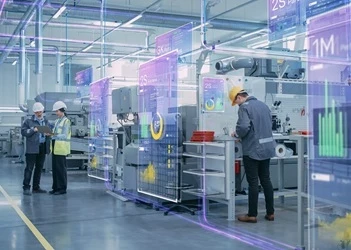Why user experience should be at the forefront of DPA initiatives
Keith Dugas, director of maintenance AI and connected operations at Air Canada, shares his greatest DPA successes and advice ahead of his session at PEX Live: Digital Process Automation 2022
Add bookmark
PEX Network catches up with Keith Dugas, director of maintenance AI and connected operations at Air Canada, who dives into his past experience with digital process automation (DPA) and reflects on one of the greatest successes for their maintenance branch. Dugas offers his advice to those looking to implement DPA in their own organizations and his predictions for what the DPA space holds in the next few years ahead of his session at PEX Live: Digital Process Automation 2022.
PEX Network: What can you tell us about your experience with digital process automation and are there any success stories that come to mind?
Keith Dugas: DPA is very relevant and closely related to robotic process automation (RPA). From my understanding there, are different nuances of how far you need to go with DPA before you are considered to be implementing RPA.
I started at Air Canada back in 2008, and I eventually became part of an operations excellence group for our maintenance organization which at the time we called the Excellence 5.0 which is now called operations excellence and serves more than just our maintenance branch. In 2017 when this all began, I was responsible for the digitalization of our paper-based line maintenance processes which essentially entailed designing and rolling out apps on an iPad.
We held several different workshops for each of the apps we designed and deployed. For one app in particular, called toolbox mobile library and made by Boeing, we determined early on that there was a feature of the activity that we had to automate which was very troublesome when done manually.
Custom app development and automation have become the industry's gold-plated standard by now, but at the time, there was no real solution. The function of the app is to house all of our technical publications, which are essentially a ‘how to IKEA guide’ but for an aircraft. If the assembly instructions of an IKEA piece of furniture are missing a page, you will look at the box and you will figure it out, but this is not possible in the case of an aircraft maintenance manual.
The aircraft manual data can be considered ‘big data’ for an iPad and for mobility since we have roughly 30 to 40 gigabytes of data that we are required to keep relevant and up to date every month.
With our partner M3Touch, we developed a DPA solution to help with updating this data. It is a kiosk that tethers together multiple technologies including Apple Configurator, RFID and an abundance of additional logic that we compiled to control every iPad that is checked into this kiosk to ensure that the iPads hold the latest content all the time.
We deployed an automated method for dealing with outdated data where we would load all the documentation to the document library that is offered through Apple. We would check every single iPad sent back into a kiosk and delete and replace files if and when needed. This was completely transparent to the users, who would just check out the iPad at the start of their shift and they would receive it with the latest up to date data.
Employees in the maintenance organization sign in through a single sign on and two-factor authentication for all their apps on the iPad and can at times forget to sign out when they check it back into the kiosk. For this reason we deployed a method to wipe all the user credentials and set the iPad back to its default settings for the next user every time an iPad is returned.
PEX Network: What is your top advice for organizations looking to implement DPA?
KD: User experience is the first and foremost consideration, so you cannot build automation where you think it inherently should be implemented. You need to solicit ideas from the people who need the automation and understand where their pain points and friction points are, in order to build it for their experience. Otherwise, you might not see its adoption from the users throughout the end-to-end process, even if you have successfully automated something within the process.
Simply put, if you are only using DPA in certain aspects of a transaction or a process without looking at an end-to-end flow, then you need to make sure that the user is part of your solution.
We had an initiative at Air Canada that we deployed almost a decade ago called "auto repair order" where we deployed automation for each repair needed and we would ask our users on a return to stock transaction if they wanted to create a repair order.
This process worked well but every time users returned an aircraft part to serviceable stock the automated system would offer the creation of a repair order for that part number and serial number regardless of needing the repair. This led to a disastrous amount of repair orders being created for parts that were returning to serviceable inventory. As we did not get user experience feedback first, we did not look into when, where and how automation fit into their process. We have since worked with our maintenance and engineering supplier and corrected this feature.
My advice for UX design workshops is to bring in some of your most experienced workers, your most junior employees that have just come out of training and somebody right in between. That way, you get the people that have always done the process a certain way, new people who might have a different perspective straight out of training and a person who could play the devil's advocate in the middle.
PEX Network: What key developments do you see happening in the DPA space over the next couple of years?
KD: Machine learning is seen by many as a black box of magic that is able to recommend where to apply automation or automate the task itself inherently, which is still to be seen.
I have been thinking of an approach using process mining combined with AI to automate recommendations on where to deploy DPA. Currently at Air Canada we run discovery process mapping sessions to understand bottlenecks and pain points, and then extrapolate to figure out where we could potentially apply DPA.
A lot of this work can take two to six months of effort and research to pinpoint. However, with a heavily transactional-based system, you can feed your transactional throughput into a process mining algorithm. This allows you to see the rework loops, understand where the repetitive functions continuously occur and easily identify where to deploy DPA as a recommendation.
PEX Network: What can attendees expect to learn from your session on how to transition from digitalization to AI and machine learning?
KD: I want to offer insights into what I have learned since we started building our digitalization pipeline and provide an understanding of where the added value truly is. The user experience approach is huge and if you have paper-based processes, do not immediately start thinking about AI. You need a digitalization strategy if you have not started yet to understand what will become digital and how. For example, you need to know if you want to deploy optical character recognition (OCR) on paper-based processes or fully digitalize them. Even if you use OCR however, you will have to train that too.
If you are already digital you need to consider what data you want the AI tool to ingest and from there, you can better assess what type of AI you will need. To achieve this you have to work backward from what the solution will do to understand what kind of tool you need, to understand what your next step needs to be. None of which is straight forward.
Most importantly, if you do not bring the user experience into play, then you will likely not get the level of adoption you need and you will not get a full understanding of what data your AI needs. I truly believe that all of these aspects are connected and with 99 per cent of all applications today, humans remain at the helm.
Learn more about Air Canada’s DPA journey by attending Dugas’ session at PEX Live: Digital Process Automation 2022 taking place on 25-26 April 2022 – you can register here.
Do you agree with Dugas’ predictions regarding the development of DPA in the coming years? Let us know your thoughts in the comments below.























